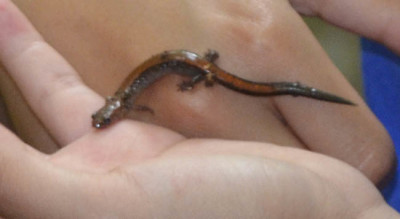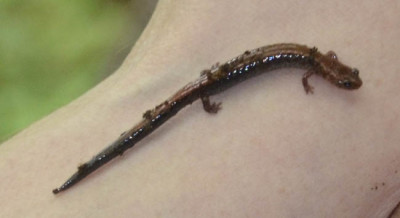For Canada Day, a group of friends and their families went for a walk near a waterfall in the Hamilton area. The path wound through a mature forest where the understory was sparse but the ground was littered with large rocks and fallen logs. Under one of these was found a Red Backed Salamander which was duly admired by all not least for its amazing jumps.

What Kinds of Salamanders Live in Southern Ontario?
There are actually several types of salamanders living in Ontario but all of them are seldom seen without a bit of searching. Salamanders to watch for include
- Blue Spotted
- Eastern Red Backed
- Four Toed
- Jefferson (Endangered)
- Northern Dusky (Endangered)
- Northern Two Lined
- Small Mouthed (Endangered)
- Spotted
Others include
- Mudpuppies
- Red Spotted Newts
Why Do I Never See Salamanders?
Like frogs, salamanders need to keep their skins moist to breathe and thrive. Unlike frogs, though, most salamanders don’t live in the water or at the water’s edge. Although they visit ponds, streams and lakes (depending on the species) to lay their eggs, adult salamanders usually live on land. To keep from drying out these adults often stay in damp surroundings such as under rocks and logs, and deep below layers of autumn leaves.
So you might see salamanders if you visit their breeding waters in the spring but later in the year you’d need to actively search for them in likely spots.
Do Eastern Red Backed Salamanders Spend Time in the Water?
Most salamanders go through a stage where they live in the water with external gills and a tadpole-like tail. Eastern Red Backed’s, though, don’t. According to the Toronto Zoo “Larval Amphibians of Ontario Identifier” the larvae develop within the egg and hatch as tiny replicas of the adults.
These eggs are not even laid in the water. Instead the mother Red Backed lays her eggs on land. She may even brood them! (Source: the ROM Field Guide to Amphibians and Reptiles of Ontario by Ross D MacCulloch.)
How Can Something as Short Legged and Long Bodied as a Salamander Leap Great Lengths?
When we (briefly) held the salamander for a closer look, it soon started walking across our hands bent on escape from this bright, dry unpleasant environment. I was expecting that. I was quite surprised, though, when it suddenly leapt for freedom. Only because the “finder” knew what to expect, was the salamander saved from a nasty plummet.
Our creature was about 6 cm long (2+ inches). Its legs, however, were just little stubs. Unlike a frog with its long legs and slingshot design, this salamander seemed unlikely to be able to hop much less leap several times its own body length.
Then I remembered reading an article about a scientist studying salamander jumps. When I got home, I went looking for it again. The CBC ran the report on the project by Anthony Hessel at Northern Arizona University. He describes the move as a “hip-twist jump.” His photos are helpful in understanding what he’s saying which is that “They pull themselves towards a planted foot, pole-vault over that limb and get into the air.” Some of the types of salamanders he was studying can jump 6 to 7 centimetres into the air.
This link to a very short video of a leaping salamander shows just how high they can go.
After a very short inspection, we returned our Red Backed Salamander to its refuge under a nice dark, damp log. I hope it realized that it made our Canada Day a little bit more wondrous for us.
Related Reading
- Who Is Playing the Banjo Badly on the Shores and in the Marshes of Southern Ontario?
- What Ontario Frog is Hopping through the Grass Instead of Jumping in the Water?
Join In
Have you had any chance encounters with salamanders? Did they leap? Please share your experience with a comment.


